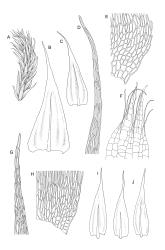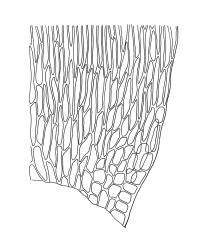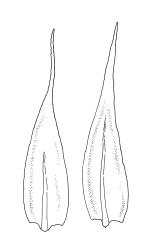- ≡ Hypnum salebrosum F.Weber & D.Mohr, Bot. Taschenb. (Weber) 312 (1807)
Plants medium-sized to robust, rather soft, yellow- to bright green, forming loose or sometimes compact mats. Stems prostrate to ascendant, irregularly but much branched, green or pale brown, to at least 70 mm long, in cross-section with a distinct central strand and 3–4 layers of thick-walled cortical cells, beset below with brown, smooth rhizoids (in fascicles on abaxial side of leaf bases). Branches variable in length, not complanate. Stem leaves erect to erect-spreading, not secund, symmetric, somewhat to strongly plicate, scarcely altered when dry, ovate-lanceolate, narrowly acuminate, usually recurved in lower half or more on one or both sides, weakly concave, not or slightly decurrent, serrulate above or nearly entire, 2.2–2.5(–3.0) × c. 0.7–1.0 mm. Branch leaves smaller, 1.8–2.2(–2.8) × c. 0.4–0.6 mm, usually more strongly serrulate (especially near apex) than stem leaves, but occasionally nearly entire, otherwise not differentiated. Costa c. 20–30 µm wide (⅓ above insertion), extending ⅔–¾ the length of the leaf (incorrectly illustrated here), often obscured by leaf plications, with an abaxial terminal spine present or absent. Upper laminal cells smooth, firm-walled, linear, (39–)75–105(–120) × c. 5–7 µm; basal cells shorter in c. 3–5 rows; alar cells quadrate, subquadrate, or short oblong, strongly differentiated, forming a moderate-sized group extending c. 12 cells up the margin and ⅓–½ towards the costa base.
Autoicous. Perichaetia lateral on main stems; perichaetial leaves ovate-lanceolate, ecostate, patent above. Perigonia narrowly ovoid, scattered (and often numerous?) on main stems, with ecostate, lanceolate bracts less than 1 mm long, and filiform, 5–10-celled paraphyses, enclosing 6 or fewer antheridia. Setae variable in length, c. 10–40 mm, smooth, weakly sinistrorse below and dextrorse immediately below the capsule, red-brown; capsules inclined to horizontal, asymmetric, oblong-ovoid, c. 1.6 mm long (excluding operculum), yellow- to dark brown; exothecial cells mostly oblong, to c. 54 µm. Annulus not seen; operculum bluntly conic. Exostome teeth lanceolate; endostome detail not seen. Calyptra c. 3 mm long. Spores c. 12–18(–21) µm, finely papillose.
Crum & Anderson 1981, fig. 510; Hedenäs 2002, fig. 2 f–g; Seppelt 2004, fig. 33.
The medium-sized to robust irregularly branched plants with clearly plicate, erect-spreading leaves (both stem and branch) that are evenly tapered and neither secund nor circinate serve to differentiate this widespread and weedy species. The alar groups are strongly differentiated and composed of ± quadrate to short oblong cells.
When sterile B. salebrosum cannot be confidently distinguished from the apparently much less common B. campestre, but when fruiting the smooth setae help to distinguish B. salebrosum. Brachythecium salebrosum also tends to have less terete stems and branches and less strongly toothed branch leaves.
Occasional confusion between B. salebrosum and B. albicans can occur. B. salebrosum differs by its autoicous sexuality, generally more branched habit and less terete stems and branches, scarcely decurrent and mostly apically denticulate stem leaves, and less regularly quadrate alar cells. The alar group is also smaller in proportion to the leaves than the alar group of B. albicans. There appears to be little difficulty distinguishing B. salebrosum from B. rutabulum in N.Z., in contrast to the situation in some parts of their overlapping ranges.
Larger forms of B. salebrosum could be confused with Palamocladium leskeoides. The latter species is largely confined to limestone and marble outcrops. Brachythecium salebrosum has smaller leaves that are not toothed towards the insertion, and non-clasping leaf bases.
Material of Ischyrodon lepturus (Fabroniaceae) is sometimes incorrectly referred to B. salebrosum. The Ischyrodon is a more compact, darker green, and exclusively coastal plant. Brachythecium salebrosum has alar cells that extend ⅓–½ to the costa base, while those of Ischyrodon extend over the adaxial surface of the costa base. The upper laminal cells of B. salebrosum are generally shorter than those of Ischyrodon.
NI: N Auckland (Kaipara Harbour, Bay of Islands), S Auckland, Hawke’s Bay (near Wairoa), Taranaki (Waitōtara River), Wellington (Ōhutu Ridge, near Ormondville, Kopuaranga); SI: Nelson, Marlborough, Canterbury, Otago, Westland (Ōtira), Southland (Eyre Mountains); M.
Bipolar; widespread in temperate northern hemisphere regions. Tasmania*, mainland Australia*, North America*, Europe* and reported from Kerguelen, northern Africa, northern and central Asia, and Japan.
A weedy species growing a range of mostly disturbed or modified habitats. These include moist soil in waste areas, in drainage ditches, in pastures, and in grazed grassland/ shrubland. This species also occurs on rotten logs and rarely on the lower trunks of willow trees. It seems to favour calcareous or nutrient-enriched habitats in N.Z. One collection has been confirmed from deer antler. On the South I. it ranges from near sea level (Kaikōura Peninsula, Marlborough L.D.) to at least 1670 m (Remarkable Range, Otago L.D.) elevation. Associated moss species include B. paradoxum, B. rutabulum, Drepanocladus aduncus s.l., and Pseudoscleropodium purum. Only one fertile specimen of B. salebrosum has been confirmed from the North I.
Hedenäs & Isoviita (1996) proposed a conserved type for the name Hypnum salebrosum F.Weber & D.Mohr. in order to preserve the modern application of B. salebrosum (F.Weber & D.Mohr) Schimp. for this widespread and well-known species.
Seppelt (2004) briefly considered the merits of the name B. austrosalebrosum (Müll.Hal.) Kindb. in his discussion of Macquarie I. collections. He opted to name the Macquarie material as B. salebrosum. Hedenäs (2002) also applied B. salebrosum to mainland Australia and Tasmanian collections.








